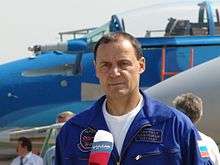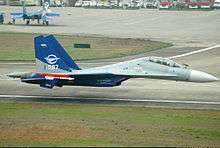Anatoly Kvochur
Anatoly Kvochur (Russian: Анатолий Николаевич Квочур, tr. Anatoly Nikolaevich Kvochur, IPA: [ɐnɐˈtolʲɪj nʲɪkɐˈlajɪvʲɪtɕ kvʲɪˈtɕʉrʲ]; born 16 April 1952), is a Russian test pilot, Hero of the Russian Federation.
Anatoly Kvochur | |
|---|---|
 Anatoly Kvochur at the MAKS-2007 airshow | |
| Born | 16 April 1952 |
| Awards | Hero of the Russian Federation (1992) |
| Aviation career | |
| Full name | Anatoly Nikolaevich Kvochur |
| Rank | |
Biography

Anatoly Kvochur was born on April 16, 1952, in the village of Mazurovka, Mohyliv-Podilskyi in the Vinnytsia Oblast of Ukrainian Soviet Socialist Republic.[1]
He studied at the V. M. Komarov Higher Military Flying School at Yeysk, graduating in 1973. He began service as a pilot in the Group of Soviet Forces in Germany. He served for two years before he was discharged from the Soviet Armed Forces in 1977 with a recommendation for admittance to the Fedotov Test Pilot School. He graduated from the school in 1978. From 1978 to 1981 he worked as a test pilot at Komsomolsk-on-Amur, testing Su-17 aircraft and its modifications. He also studied further at the Moscow Aviation Institute, from whence he graduated in 1981.[2][3]
He was transferred to the Mikoyan Design Bureau where he participated in the testing of more than 80 types of aircraft, including MiG-21, MiG-23, MiG-27, MiG-29, MiG-31, as well as air-to-air and air-to-surface missiles.[1] Since then he has appeared in numerous international air shows, showcasing Russian aircraft.
In 1995 Kvochur participated in a very long range flight demonstration of Su-27PD and Su-27PU Flankers featuring an inflight refueling probe. He led an aerobatic team, known as the Test Pilots Team (Lyotchiki-Ispyttahteli), which also included the pilots Vladimir Loginovsky and Alexander Garnaev.[4]
Paris Air Show incident
Kvochur was involved in an airshow accident on 8 June 1989 at the Paris Air Show. He was flying a single-seater Mikoyan MiG-29 Fulcrum 'Blue 303', the latest fighter aircraft of the Soviet Union at the time. While executing a low-speed, high-angle attack portion of his routine,[5] a bird was sucked into the turbofan of his right engine (a bird strike), causing the engine to burst into flames. Kvochur immediately turned the remaining engine to full afterburner. However his speed, at 180 kilometres per hour (110 mph), was too slow to maintain stability on one engine. Despite his efforts, the stricken aircraft went into a steep dive. Kvochur managed to steer the MiG away from the crowd and eject 2.5 seconds before impact. He landed 30 metres (98 ft) away from the fireball of the crashed plane.[6] The incident was caught on video and is featured on the reality television series World's Most Amazing Videos.[7][8]
The aircraft Kvochur was in had a Zvezda K-36D ejection seat at that time.[9] The same ejection seat also helped save the lives of the pilots of two MiG-29s that collided mid-air at the Royal International Air Tattoo four years later, on 24 July 1993,[10] and the pilot and navigator of a Sukhoi Su-30 that crashed from a tail-strike at the Paris Air Show on 12 June 1999 (which was also captured on video).[11][12]
Awards and recognition
- Order "For Merit For The Fatherland" 3rd Class (15 January 1998)[13]
- Hero of the Russian Federation (17 November 1992)[14][15][16]
- Merited Test Pilot of the USSR (8 August 1990)[16]
- Order of the Red Banner of Labour (1988)[16]
References
| Wikimedia Commons has media related to Anatoly Kvochur. |
- "Kvochur Anatoly Nikolayevich". OKB MiG Design Bureau. Retrieved April 16, 2011.
- Peter Dancey (2011). Russian Test Pilot - Anatoli Kvochur A biography. Smashwords.
- Знаменская, Наталья, ed. (2002). ШЛИ со временем [ShLI in Time] (in Russian) (2 ed.). Жуковский: ООО "Редакция газеты "Жуковские вести". p. 400.
- "Sukhoi Su-30". Lyotno-Isslyedovatyelskij Institut imyeni Gromova (ЛИИ = LII). Archived from the original on 25 May 2011. Retrieved April 17, 2011.
- "Soviets Fall and Fly at the Paris Air Show". New Scientist. Reed Business Information. 122 (1669). 1989. ISSN 0262-4079. Retrieved April 17, 2011.
- Johnson, Reuben (June 18, 2007). "The Paris Air Show, Twenty Years On". The Weekly Standard. Retrieved September 18, 2009.
- June 8, 1989 Mig-29 crash at Paris Air Show on YouTube
- Испытатели. Выжить в катастрофе [Test pilots. Survive in an accident] (in Russian). Wings of Russia Studio.
- Todor Ivanov Ginchev. "MiG-29 Fulcrum". tig.ludost.net/. Archived from the original on August 31, 2011. Retrieved April 17, 2011.
- "Pop Goes the Russian". Popular Science. Bonnier Corporation. 245 (6). 1993. ISSN 0161-7370. Retrieved April 17, 2011.
- Stamford, Lincs., UK: Air Forces Monthly, Alan Dawes, "That Crash - at Le Bourget", August 1999, Number 137, pages 50-53.
- June 12, 1999 Su-30MKI crash at Paris Air Show on YouTube
- Presidential Decree of 15 January 1998 № 38
- Presidential Decree of 17 November 1992 № 1401
- "Decree of the President of the Russian Federation on 17 November 1992 N 1401 "Awarding the title of Hero of the Russian Federation, test pilots Flight Research Institute named after Gromov" (Указ Президента РФ от 17 ноября 1992 г. N 1401 "О присвоении звания Героя Российской Федерации летчикам-испытателям Летно-исследовательского института имени М.М. Громова")" (in Russian). Правотека.ру. Retrieved April 17, 2011.
- Квочур Анатолий Николаевич 1952 (in Russian). TestPilot.ru. Retrieved April 16, 2011.